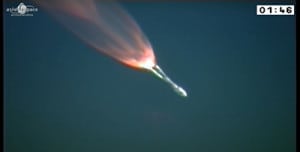Launch Anomaly Leaves Uninsured Galileo Satellites in Flawed Orbit
[Via Satellite 08-25-2014] The Aug. 22 Soyuz launch originally celebrated as the beginning of the European Space Agency’s (ESA) fast-paced deployment of the Galileo Global Navigation Satellite System (GNSS) is now the subject of investigation after officials discovered the two satellites did not reach their intended orbits. The first two Full Operational Capability (FOC) satellites, named “Doresa” and “Milena,” were carried into an elliptical orbit with an eccentricity of 0.23 degrees and inclined at 49.8 degrees with a semi-major axis of 26,200. The spacecraft were intended for a circular orbit inclined at 55 degrees with a semi-major axis of 29,900 kilometers.
The mission’s first steps occurred normally. It was not until after separation of the Fregat upper stage that the satellites were discovered in a noncompliant orbit. Launch provider Arianespace reports ongoing analysis at Kourou, French Guiana where the Soyuz was launched. A consortium of associated parties including the Russian space agency Roscosmos, Arianespace customer ESA, and Russian manufacturers RKTs-Progress and NPO Lavochkin are all participating in the investigation of the anomaly. Spearheading the examination is Chairman and CEO of Arianespace Stéphane Israël.
Israël added that Arianespace, ESA and the European Commission are creating an independent inquiry board focused on determining the reason for the anomaly. Once the problem has been identified, the board is expected to prescribe corrective actions to enable the safe launch of Soyuz rockets from the Guiana Space Center (CSG) “as quickly as possible.”
Peter Dubock, former ESA Inspector General has been selected to chair the commission. ESA Deputy Inspector General Toni Tolker Nielsen, former Technical Director Michel Courtois, and Galileo Program Technical Officer Giuliano Gatti are also on the commission. Roscosmos Deputy Director General of TsNIImash, Alexander Daniliuk was selected as board liaison, and the French Space Agency CNES has delegated its Inspector General Isabelle Rongier.
Two academics, Professor of Flight Mechanics Guido Colasurdo, from the University of Roma “Sapienza,” and Wolfgang Kubbat, professor and former head of the Institute of Flight Systems and Automatic Control at the Technical University of Darmstadt, are also on the commission. Representing the European Commission is Paul Flament, head of unit for Galileo and Egnos program management, DG for enterprise and industry. The commission is expected to submit initial conclusions as early as Sept. 8, 2014.
For ESA, the launch anomaly adds to a growing list of problems that have arisen throughout the Galileo program. Of the four previous satellites already in orbit, three have experienced anomalies with no identified common mode of failure. It is not yet known what impact the new orbital arrangement will have on the 12-year lifetime of the satellites. This latest launch, however, may push ESA closer to Galileo’s margin: the agency’s website previously called for 27 operational satellites and three in-orbit spares. In an Aug. 22 statement the agency said six are designated as spares.
ESA officials said on an Aug. 20 conference call that the agency preferred a greater number of spares and launches in lieu of insurance. OHB System and SSTL are building 22 satellites, which when combined with the four Astrium and Thales Alenia Space Italy-built predecessors, would bring the total constellation up to 26. The last four have not yet been decided on as far as procurement.
“We are in a way self insured due to our procurement process,” explained Didier Faivre, ESA’s director of navigation programs. “And we prefer to invest in hardware or launch services than to go to the insurance market. If something is going wrong, we use spares.”
Arianespace is contracted to launch the 22 FOC satellites using three Ariane 5s and five Soyuz rockets. ESA said before the latest launch that it hoped to launch six to eight satellites per year. It is not clear what effect the recent anomaly will have on that schedule.
“Arianespace is determined to help meet the European Union’s goals for the Galileo program without undue delay,” said Israël. “While it is too early to determine the exact causes, we would like to offer our sincere excuses to ESA and the European Commission for this orbital injection that did not meet expectations.”
According to Arianespace, the Fregat upper stage has been depressurized normally, purged of residual fuel, and the two Galileo satellites pose no threat to people on the ground from their elliptical orbits. ESA’s Operations Center in Darmstadt, Germany has acquired control of the satellites.
